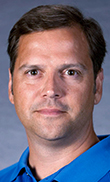Students create designs to rebuild town devastated by 2012 tornado

Gregory Luhan
Residents in West Liberty, a small Kentucky town ravaged by a deadly 2012 tornado, partnered with 20 Texas A&M environmental design students this spring to develop solutions for accelerating the town’s beleaguered recovery.
The massive storm, with a peak wind of 165 miles per hour, hit the town of 3,400 on March 2, 2012, claiming six people, injuring 75 and leaving a mile-wide path of destruction that continues to impact the economy.
Seeds of the town’s partnership with Texas A&M student designers were sown days after the tornado struck, when Gregory Luhan, then an architecture faculty member at the University of Kentucky, traveled to West Liberty because his nine-year-old daughter wanted to share her toys with the victims, many of whom lost everything in the storm.
Two years later, Luhan, now a visiting associate professor of architecture at Texas A&M, met with the same West Liberty residents he’d met in the storm’s aftermath to see if his students could aid the town’s recovery. “It’s been two years, and nothing’s been done,” they told him.
Luhan’s students accepted the challenge and began working with the town’s mayor and a steering committee of 30 citizens that soon doubled in size.
Meetings via Skype took place at the beginning of the semester, and last February, Luhan and five students from the studio traveled to West Liberty to lead a town hall meeting that drew 250 residents.
There they discussed replacing buildings destroyed by the tornado and kickstarting the West Liberty economy by reinventing it as an ecotourism hub for the region’s numerous natural tourist attractions.
“The steering committee actually functioned as a client in an architect/client relationship and there was a very fruitful dialogue,” said Luhan. “By talking about the town’s future with its residents, students were able discuss how design could enhance the town’s future by generating income,” he said.
On April 26, Luhan and 10 students traveled to West Liberty to present their final design concepts.
The students’ ideas included two new restaurants, a coffee shop, an interactive history museum including a military and genealogy section, a general store with a bike shop, a brewery, a boutique hotel, a farmer’s market and an “idea factory” where artists and creative types could incubate their ideas and turn them into marketable products.
The projects and concepts aimed at reviving the town were reviewed by Master of Land and Property Development students under the direction of Geoffrey Booth, holder of the Youngblood Endowed Professorship in Land Development at Texas A&M.
“Appealing to the niche market of ecotourism will create a steady stream of visitors, increasing local business revenues and tax collection,” said Kathryn Thompson, an MLPD student. “The combination of lower occupancy costs, increased development, increased business revenues and increased tax revenues,” she said, “will create a strong local economy.”
Despite having only six weeks to work on the design phase of the project, Luhan said his students presented clear, well-defined ideas about how architecture could create a cohesive community, a sense of place and a path toward a continued recovery from the tornado.
“We wanted to get the community to realize there was a world of potential they had not been participating in and we used architecture as the tool to do that,” said Luhan.
Tags
- arch gallery
- architecture
- archone gallery
- environment
- graduate work
- outreach
- partnerships
- rss
- studio projects
- undergraduate work
Related Posts

Students creating high-density plans for Texas A&M

BED student designs 'Real Projects' home

Treatment center designs aid PTSD, head-injured vets

Alums help students design lost school models from memory

Students create new designs for children’s treatment center
Follow Us
Facebook Twitter Vimeo Youtube Flickr RSS
Recent Posts

Planning prof heads study of disaster housing aid

A message from the dean

Former student remembered as expert planner

Leading educator named new head of Architecture Dept.


















_thumbnail_small.png)
